Adventures in Volunteering.
By Ernie Bies.
January 23, 2025.
Early Hearst to 1963
We were a family of volunteers. My brothers and sisters were leaders in their communities and we credit our mother with instilling this sense of community in all of us. We grew up on a farm in northern Ontario, living off the land and our mother insisted on sharing with the less fortunate. Her rule on Christmas morning was to feed the animals in the barn before we could start our celebrations. She would send us out with some of her special Slovak baked goods to share with the bachelors along our farm road. An ocean away from their families, they had tears in their eyes as they received the baked goods and treated us to candy and nickels.
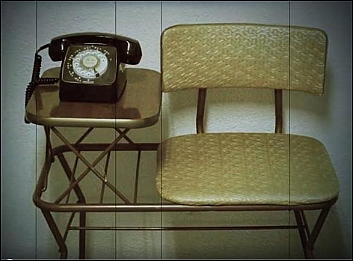
In High School I was the fund-raising
champion selling raffle tickets for
the school dances. When my mother won
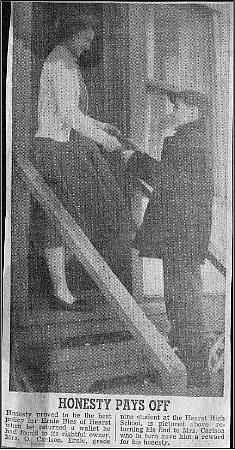 the telephone table being offered as a
prize one year, sales were a bit tougher.
the telephone table being offered as a
prize one year, sales were a bit tougher.
Finding and returning a lost wallet earned a recognition in the press.
Toronto 1963-67
Post high school days at Ryerson Institute of
Technology were more about partying than
volunteering but opportunities did arise. I
canvassed for Liberal candidate Ian Wanless and
the reward was a thank you party at the Royal York with an open bar.
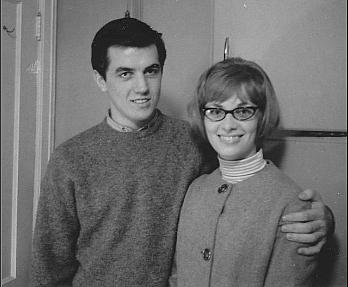 This was not really a good idea as I
found out to my chagrin that self
control is a learned skill. Through
the Ryerson Civil Club, we accepted
and won the fundraising challenge
for the United Way and also
organized dances whose purpose
was to introduce males to females.
This was not really a good idea as I
found out to my chagrin that self
control is a learned skill. Through
the Ryerson Civil Club, we accepted
and won the fundraising challenge
for the United Way and also
organized dances whose purpose
was to introduce males to females.
I won a lifetime prize through one of these dances when I met my future wife, Sandy, through a past connection to Hearst.
Ottawa 1967-77
Being the new guy in the office I was assigned the fundraising chores
which usually meant passing a jar to collect money. Seeing that the
early donations were just small change, I salted the jar with a $5 bill and
donations increased. In 1975, the first of the Vietnamese boat-people
began to arrive in Ottawa. We had a friend named Nghia Truong who
operated a Shoppers Drug Mart in downtown Ottawa. He asked if I
could help with an evening conversational English program that he was
organizing to assist the new refugees with their integration into
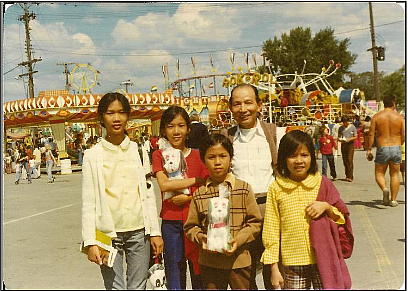 Canadian life. This was to
supplement the formal training
they received during the day. I
recruited my wife and several
work colleagues to assist. We
would simply engage them in
conversation role-playing
everyday activities like ordering
meals in a restaurant or asking for directions. I took a group to the
Central Canada Exhibition and went to the boss of the Conklin shows for
help. He gave me a roll of tickets for the rides and games and they came
away with stuffed animals and wonderful memories. The man in the
picture was a professor who was working as a security guard until he
could learn English.
Canadian life. This was to
supplement the formal training
they received during the day. I
recruited my wife and several
work colleagues to assist. We
would simply engage them in
conversation role-playing
everyday activities like ordering
meals in a restaurant or asking for directions. I took a group to the
Central Canada Exhibition and went to the boss of the Conklin shows for
help. He gave me a roll of tickets for the rides and games and they came
away with stuffed animals and wonderful memories. The man in the
picture was a professor who was working as a security guard until he
could learn English.
Edmonton 1977-1983
When living in Edmonton back in the late 70s, I would volunteer with
Santa's Helpers to deliver Christmas gifts to families in need. Being a big
fellow, I was assigned the 98th Street deliveries which was a rough part
of town in those days. I had the old blue Maverick loaded to the gills
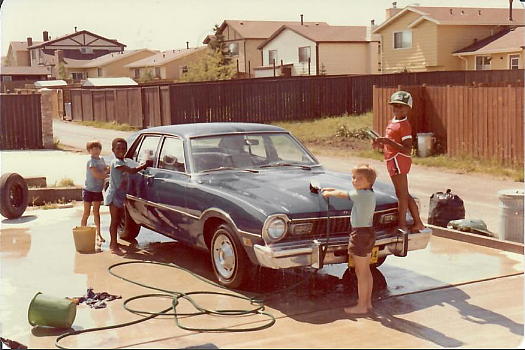 with bags of gifts
and goodies. The
children receiving
the gifts would be
waiting at the door
in anticipation and
they did not wait
until Christmas to
tear open their
gifts. One
interesting family
were recent immigrants from Poland who were taking English language
training while awaiting job placement. They were both professionals
and their names were on the welfare list as they were receiving
temporary assistance. Since many Eastern Europeans can understand
each other's language, I attempted to explain in Slovak that these were
welcoming gifts from the city. They were astounded that the city would
think of them at this time and I'm sure became very productive citizens.
with bags of gifts
and goodies. The
children receiving
the gifts would be
waiting at the door
in anticipation and
they did not wait
until Christmas to
tear open their
gifts. One
interesting family
were recent immigrants from Poland who were taking English language
training while awaiting job placement. They were both professionals
and their names were on the welfare list as they were receiving
temporary assistance. Since many Eastern Europeans can understand
each other's language, I attempted to explain in Slovak that these were
welcoming gifts from the city. They were astounded that the city would
think of them at this time and I'm sure became very productive citizens.
One night I was trying to do my last delivery and could not get the people to come to the door. I could see a light on upstairs so went into the back yard to try the back door. This timid man finally came to the door and only opened it enough to get the gift bag through. Thinking that was kind of strange I drove home down 98th St. and noticed several police cars with lights flashing and Policemen going door to door on both sides of the street. The next morning, I heard on the news that a drunken card party ended in a free for all with two people stabbed to death and the killer on the loose. My wife officially retired me from driving on the spot.
We lived in a new development called Woodvale where a large lot was set aside for a playground. After a couple of years and no action on the playground, I went to a meeting of the Community Association and was told that the Association had to come up with $25,000 that the city would match before they would build the playground. Their fundraising efforts were not successful and they were actually losing money running a Bingo because they were committed to give out prize money independent of the size of the crowd. They had a no-win location in an industrial area which had no bus service. I made a phone call to a neighbor, Ron Ashmore, whose mother was a Bingo fanatic and asked if he would co-chair the Bingo committee with me. We did not do well at the original location and found a new venue in a shopping mall that had other amenities and bus service. Slowly we started showing a profit and made the whole experience a fun thing for the volunteers. We posted their names in the community newspaper every week and thanked them for contributing to the new playground. We also all went for Pizza after each Bingo so it became a community building exercise that more and more people wanted to be part of. Neighbours would stop us in the mall and ask if they could help. We held a marathon 24-hour bingo that sold out well in advance. By the end of the year, we had raised the required $25,000 and our playground was set in motion. Fundraising continued as other community projects were addressed, including construction of a community centre.
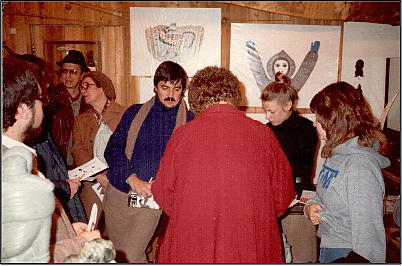
Another major activity in
Edmonton was helping organize
an Art interest group called the
Inuit Art Enthusiasts. Having
spent three summers surveying
in the Arctic. I had developed a
strong interest in the art and
culture of the Inuit. I would line
up for the annual release of the
Cape Dorset print collection outside the Canadiana Galleries with
several collectors. Sometimes we would line up at midnight the night
before in order to secure a high priority choice for the prints when they
went on sale in the morning. Friendships were formed which led to
social gatherings to discuss Inuit Art and share stories. Some of the
people in line had been to a
conference in Winnipeg and came
back with the idea of starting an
interest group in Edmonton and thus
the Inuit Art Enthusiasts was born.
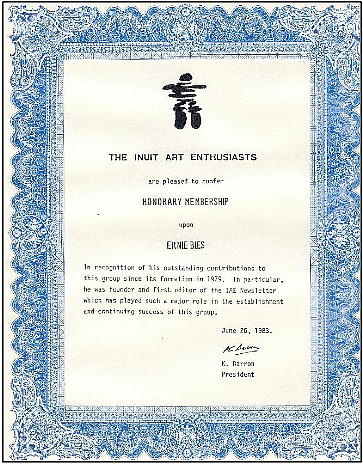 We would have regular meetings
featuring speakers on a variety of
subjects related to Inuit Art, framing,
copyright etc. as well as conferences
attended by foremost experts in the
field like James Houston and George
Swinton. My strength was
researching stories on Inuit Art from
various publications and finding
exhibitions in galleries from all over
Canada and the United States. These were shared in a newsletter.
We would have regular meetings
featuring speakers on a variety of
subjects related to Inuit Art, framing,
copyright etc. as well as conferences
attended by foremost experts in the
field like James Houston and George
Swinton. My strength was
researching stories on Inuit Art from
various publications and finding
exhibitions in galleries from all over
Canada and the United States. These were shared in a newsletter.
Then I was transferred back to Ottawa.
Ottawa 1983 - present
Volunteering revolved around my son's activities. When I tried to enrol him in Cubs we were turned away because there were not enough leaders. So, I became Mang, the newest leader with a 6 pack (of cub scouts). This was quite enjoyable as I took them to tour the Parliament buildings and on a field trip by train to Smith Falls to see the Hershey Chocolate factory, where I learned that I still had not perfected the art of self control and suffered for it. Another outing was to a cabin at Mont St. Marie. It was a rainy weekend and after a day of indoor activities trying to amuse a hyperactive group of boys, we told them to put on their heaviest clothes and took them for a walk in the woods. Stumbling through the bush, I heard one boy complain, "This is the worst thing I have ever done in my life." I asked him if he had ever eaten liver. He said "This is the second worst thing I have ever done in my life."
Having lived on a farm as a boy I missed out on all the activities that were available to town kids, but made up for them now. There was always a shortage of leaders, coaches and managers in any organization so when my son wanted to play baseball I became a coach, when I signed him up for soccer, assistant coach. Later it was hockey manager and so it went. It was interesting to see that the same core group of parents would take on these roles in every organization.
Managing hockey teams had its challenges. Before long I knew every
arena in the city and surrounding towns as we travelled far and wide for
exhibition games and tournaments. Often this required white-knuckle
drives in snow and ice conditions to places like Pembroke and Shawville.
I usually had to take other players as I had a seven-passenger van. They
would sleep in the back, oblivious of the driving conditions. Finding
rental ice for practices was difficult until I noticed that a sheet of ice in
our local arena was often unused. I learned that the competitive teams
were assigned prime time ice and often left it unused if they were out
of town for tournaments or exhibition games. I called all the coaches of
the competitive teams and asked them to let me know when thy had
ice to spare. I kept the best times for my team and passed on
opportunities to other house league managers. When our team
participated in out-of-town tournaments, we had our share of success
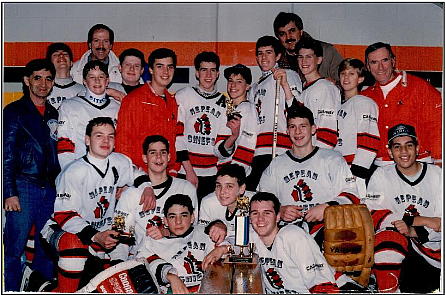 and memories. At one
tournament in Renfrew, I
took the team out for lunch
between games. The arena
was a couple of blocks from a
KFC and I marched them over
and ordered a couple of
buckets. They sat on the
curbs of the parking lot and
wolfed down chicken and french fries exclaiming what a great
experience it was. I am sure the mothers were less than impressed.
and memories. At one
tournament in Renfrew, I
took the team out for lunch
between games. The arena
was a couple of blocks from a
KFC and I marched them over
and ordered a couple of
buckets. They sat on the
curbs of the parking lot and
wolfed down chicken and french fries exclaiming what a great
experience it was. I am sure the mothers were less than impressed.
Nepean Minor Hockey (NMHA) had about 100 teams ranging from Development through Atom, Bantom, Midget and Juvenile with 8 to 10 House League teams in each category plus Competitive A and B teams in the higher age groups. All of these teams needed sponsors. I joined the administration of the NMHA; I found that they needed the most help in seeking sponsors so I took on the challenge. They only had about 60 sponsors committed which affected their budget, requiring the parents to pay more. I made up a call letter seeking sponsors and hand-delivered it to every business in Nepean. I did not try to make a pitch, just left the flyer for the boss. My phone rang off the hook and soon I had filled all the vacant sponsor positions and was still getting calls. I convinced them to pay the sponsorship fee and be put on a waiting list. Their money would go towards a . . . Player Assistance Fund that was created on the spot. One of our biggest sponsors was Myers Motors who had a team in each division. To free up space I convinced them to sponsor the Player Development Program that suited their sense of grassroots community involvement.
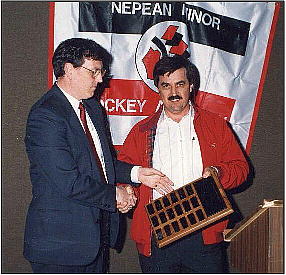
I am sure I got as much enjoyment out of these activities as my son did and received recognition with the President's Award from the Nepean Minor Hockey Association and with a Volunteer Award from the City of Nepean.
Another area of need at the NMHA was in administration, where 20 volunteers covered 30 positions. With about 2000 kids in the program, it should have been easy to fill those positions. I found that there were people out there willing to help but they were hesitant to step forward. One of my jobs was as a convener of the games. This involved observing the games to make sure things ran smoothly. All the referees were also kids from older age groups in the league that made a few dollars refereeing. They were young and inexperienced and at times they missed calls. The wannabe referees in the stands became very vocal and vented their frustrations at the referees or the convener. I started carrying volunteer forms in my pocket and invited the more boisterous fans to sign-up and take on the responsibilities. Most quietly went back to their seats but at least three signed on and became excellent directors in the association.
On one of my work trips to Edmonton I sat beside a lady on the plane
who was the Ottawa manager for the Entertainment Coupon Book that
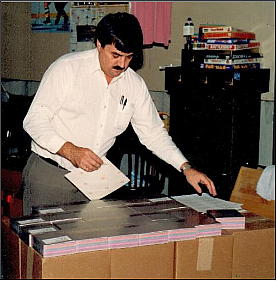 she was promoting as a fundraiser for
charities. From that chance meeting, the
Entertainment Book became a major
source of funds for both Nepean Minor
Hockey and later for Nepean Kiwanis.
The team I managed benefitted from
many Entertainment book related perks,
like team jackets, personalized hockey
bags, trips to see wrestling at the Civic
Centre in Ottawa and ultimately a bus trip to Montreal to see the
Canadiens play the Edmonton Oilers.
she was promoting as a fundraiser for
charities. From that chance meeting, the
Entertainment Book became a major
source of funds for both Nepean Minor
Hockey and later for Nepean Kiwanis.
The team I managed benefitted from
many Entertainment book related perks,
like team jackets, personalized hockey
bags, trips to see wrestling at the Civic
Centre in Ottawa and ultimately a bus trip to Montreal to see the
Canadiens play the Edmonton Oilers.
Before long I was asked to join the Kiwanis Club of Nepean where I chaired the Community Services and Ways and Means committees and was the long-time treasurer.
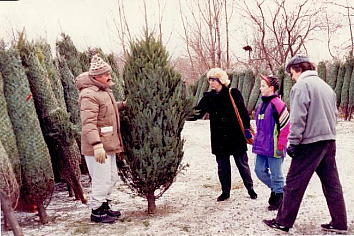
Every Kiwanis member participated in various projects such as Christmas Tree sales and operating the food booth at the annual Nepean Days Festival. This included serving hamburgers and french fries, a Saturday night chicken dinner and a Sunday morning Father's Day pancake breakfast. Members also assisted other organizations such as the Cancer Society with Daffodil sales, the Salvation Army with their Christmas Kettle and serving Christmas and Thanksgiving dinners at Foster Farms, a social housing project.
As Ways and Means Chair, I brought in new fundraising projects such as
Christmas Cake Sales, Garage Sales, Halloween Pumpkin Sales and
participating in the largest Duck Race in the world where 90,000 rubber
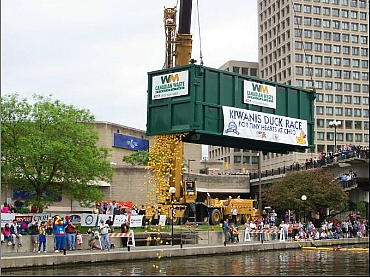 duckies were dropped into the
Rideau Canal to race for big prizes in
support of the Children's Hospital.
Our biggest fundraiser turned out to
be the sale of Entertainment books
which brought in $25,000 every year.
duckies were dropped into the
Rideau Canal to race for big prizes in
support of the Children's Hospital.
Our biggest fundraiser turned out to
be the sale of Entertainment books
which brought in $25,000 every year.
The Community Services Committee allowed us to see where the money we raised was going. We also had fun projects such as Adopt a Road and the World Trivia Contest. There was never a shortage of activities to occupy our members.
Everyone has a friend who is a loveable rogue like Percy. He was a natural salesman with constant good cheer who was always looking for a deal, but when asked, was the first to help out. When I was the manager of our minor league hockey team, Percy would ask if I could pick up his son for the game. When I arrived, his son got in the van and Percy got in the front seat. I asked where he was going and he just said "to the game" I guess the manager was expected to provide transportation. On one occasion I thought I had outwitted him saying I was already picking up the next-door neighbour. Ten minutes later Percy called and said I had to pick them up too as he had just invited the next-door neighbour's son for a sleepover. There was nothing vindictive, it was just a game. The topper was when I was at a sports store where we got our supplies and saw a jacket that he had ordered with his son's name on it. I called him to say it was ready and he asked me to pick it up. After my objection that it had to be paid for, he asked to speak to the store manager to allow for later payment, and then asked me to drop it off. I said I had other chores, like going to the liquor store. Without missing a beat, he said "Pick me up a bottle of scotch." I said "what kind?" His answer, "I don't know, I don't drink scotch." So, I delivered the jacket and the scotch.
The closest I got to beating Percy was at the Christmas Tree lot where our trees sold for twenty dollars each. He asked for a discount and I said he could have two for thirty-five dollars. He jumped on the deal and as he was dragging his two trees out, his son asked why they needed two trees? "I don't know" was his terse response. They lived in a large bungalow and apparently from then on, their Christmas tradition was to put up two trees, one at the front door and the other in the living room.
Busy as I was with work and
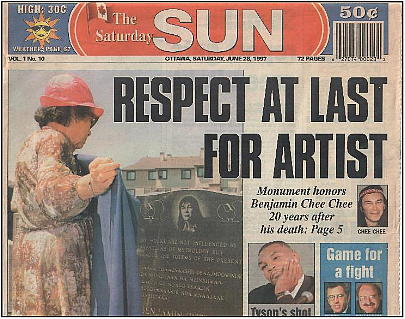 Kiwanis there was still time to
volunteer at Ted Long's
Christmas Dinners at Sonny's
Restaurant and to support the
Odawa Friendship Center with
their annual Art Auction and
Dinner. The Ottawa Native
Concerns Committee was very
special to me as they had
learned that the famous artist Benjamin Chee Chee was lying in an
unmarked grave. Benjamin was a good friend until his sad death in
1977. Twenty years later I was a member of the committee that raised
$14,000 to erect a proper headstone on his grave. A Benjamin Chee
Chee day was organized in Ottawa and Vanier with dawn to dusk
ceremonies honouring his memory, attended by his mother and two
busloads of close friends from the Bear Island Reserve near Temagami.
Kiwanis there was still time to
volunteer at Ted Long's
Christmas Dinners at Sonny's
Restaurant and to support the
Odawa Friendship Center with
their annual Art Auction and
Dinner. The Ottawa Native
Concerns Committee was very
special to me as they had
learned that the famous artist Benjamin Chee Chee was lying in an
unmarked grave. Benjamin was a good friend until his sad death in
1977. Twenty years later I was a member of the committee that raised
$14,000 to erect a proper headstone on his grave. A Benjamin Chee
Chee day was organized in Ottawa and Vanier with dawn to dusk
ceremonies honouring his memory, attended by his mother and two
busloads of close friends from the Bear Island Reserve near Temagami.
Having spent my entire working career on projects in the Canadian
Arctic I maintained many friendships over the years dating back to
1968. Some of these friends would come to Ottawa for medical
treatment, vacations or work-related activities. Many would call
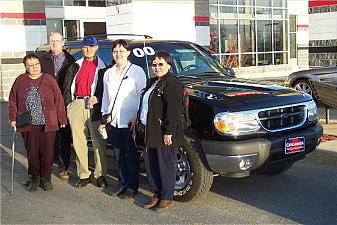 me to help them get around Ottawa.
Their destinations of choice were
Lee Valley and Home Depot for
tools, Barron's Outfitters for hunting
equipment, Value Village for clothes
and Flea Markets for fun. It seems that no request was off limits. One
lady lost a lens in her glasses in the waters off Cape Dorset. A trip to a
full-service optician in Bayshore Shopping Centre resulted in an eye test
and new glasses in about four hours. She said that would take a year
back home. A request to buy a new pickup was fulfilled with a trip to
Car Canada where a $25,000 truck was bought and arrangements were
made to ship it to Cape Dorset by Sea Lift the following summer.
Another time saw me mailing a hunting rifle up north. Who knew that
the Post Office provided that service? The most recent request was for
a box of hardwood flooring to finish a home renovation in Cape Dorset.
Easily purchased at Rona for $130, it was shocking to see that the
shipping cost, for a 22-kilogram box. was $255 by air freight. The air
freight rate of $11 a Kilo requires very careful pre-planning of needs to
make use of the summer Sea Lift as a more affordable alternative.
me to help them get around Ottawa.
Their destinations of choice were
Lee Valley and Home Depot for
tools, Barron's Outfitters for hunting
equipment, Value Village for clothes
and Flea Markets for fun. It seems that no request was off limits. One
lady lost a lens in her glasses in the waters off Cape Dorset. A trip to a
full-service optician in Bayshore Shopping Centre resulted in an eye test
and new glasses in about four hours. She said that would take a year
back home. A request to buy a new pickup was fulfilled with a trip to
Car Canada where a $25,000 truck was bought and arrangements were
made to ship it to Cape Dorset by Sea Lift the following summer.
Another time saw me mailing a hunting rifle up north. Who knew that
the Post Office provided that service? The most recent request was for
a box of hardwood flooring to finish a home renovation in Cape Dorset.
Easily purchased at Rona for $130, it was shocking to see that the
shipping cost, for a 22-kilogram box. was $255 by air freight. The air
freight rate of $11 a Kilo requires very careful pre-planning of needs to
make use of the summer Sea Lift as a more affordable alternative.
My main focus for the last fifteen years has been the history and
promotion of my home town, Hearst Ontario. In 2008, there were five
books written about the francophone pioneers of Hearst and area. A
group of us decided that we should write about our families as a
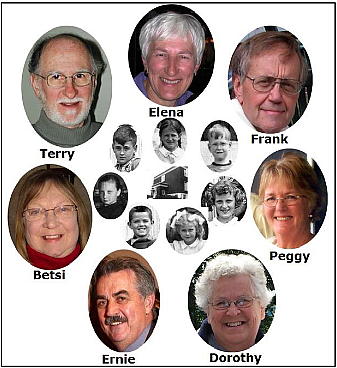 companion record to these French books. We formed a committee and
contacted about 150 families who were connected to the Hearst Public
School to ask them to document their
family history. Our committee
members all went through Hearst
Public School in the fifties when our
principal was Clayton Brown. The
working title of our project paid
Homage to Mr. Brown and our book
was titled "Clayton's Kids, Pioneer
Families of Hearst Public School." We
expected to receive 20 or 30 stories
and publish a book of about 200 pages.
The stories kept coming in well past our deadline and the final total was
106 stories and 400 pages with a CD containing 1,000 pictures. We
priced the book at $30, printed 600 copies and recruited a Northern
crew of volunteers to plan a Homecoming for the book release. They
planned for 100 attendees. Four
hundred people from all over Canada
and parts of the United States,
showed up and they turned a profit of
companion record to these French books. We formed a committee and
contacted about 150 families who were connected to the Hearst Public
School to ask them to document their
family history. Our committee
members all went through Hearst
Public School in the fifties when our
principal was Clayton Brown. The
working title of our project paid
Homage to Mr. Brown and our book
was titled "Clayton's Kids, Pioneer
Families of Hearst Public School." We
expected to receive 20 or 30 stories
and publish a book of about 200 pages.
The stories kept coming in well past our deadline and the final total was
106 stories and 400 pages with a CD containing 1,000 pictures. We
priced the book at $30, printed 600 copies and recruited a Northern
crew of volunteers to plan a Homecoming for the book release. They
planned for 100 attendees. Four
hundred people from all over Canada
and parts of the United States,
showed up and they turned a profit of
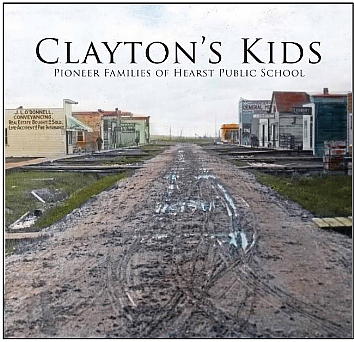 $11,000. The 600 copies of the first
edition sold out at the Homecoming
weekend so we ordered a second
printing of 600 copies. Those also sold
out in short order and we realized a
profit of another $19,000 on the book
sales. The public school in Hearst,
now called Clayton Brown Public School, was down to an enrollment of
about 50 students with a limited budget for some programs. We
donated the entire $30,000 to the school and they utilized it for the
next dozen years to pay for minor programs like milk, breakfast, lunch,
swimming, music and travel.
$11,000. The 600 copies of the first
edition sold out at the Homecoming
weekend so we ordered a second
printing of 600 copies. Those also sold
out in short order and we realized a
profit of another $19,000 on the book
sales. The public school in Hearst,
now called Clayton Brown Public School, was down to an enrollment of
about 50 students with a limited budget for some programs. We
donated the entire $30,000 to the school and they utilized it for the
next dozen years to pay for minor programs like milk, breakfast, lunch,
swimming, music and travel.
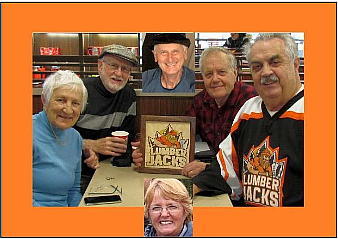
When Hearst gained a junior A hockey
team in 2017, the Lumberjacks, the
original Claytons Kids Committee
bought a pair of season tickets to
support them.
Although none of
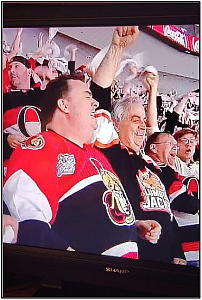 us live in Hearst
and can attend the games, we have renewed these
tickets every year and they are donated to students,
seniors and others in Hearst. I wear my Hearst
Lumberjacks jersey to Ottawa Senators games and
it has become a magnet for Hearst ex-pats and
other folks from Northern Ontario.
us live in Hearst
and can attend the games, we have renewed these
tickets every year and they are donated to students,
seniors and others in Hearst. I wear my Hearst
Lumberjacks jersey to Ottawa Senators games and
it has become a magnet for Hearst ex-pats and
other folks from Northern Ontario.
After my experience working on this book, I decided to research the history of Hearst. Over the next dozen years, I gathered all the information I could from the National Archives in Ottawa, The Ontario Archives in Toronto and the local resources in Hearst. Soon I had bulging files of Hearst History and no clear plan on what to do with it. I started writing individual stories that were published in local papers and a magazine in Northern Ontario. In 2021 I created a Facebook group called Hearstory to share these stories. We now have 3800 members with many contributing their own stories. Today readers can browse through more than 150 stories and 5,000 pictures documenting the history of Hearst as far back as 1908.
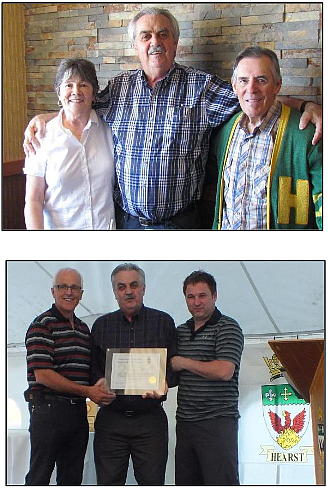
In addition to the historical research, after attending too many funerals and hearing too many eulogies, I decided that we should meet in happier times and Hearst Café was born. We meet for lunch twice a year in Ottawa, and our attendance is up to 60 Hearst ex-pats living in the area.
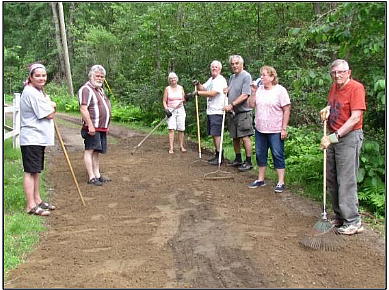
The town of Hearst recognized my promotional efforts and created a new volunteer position called Ambassador of Hearst.
Now retired and spending summers at
the cottage there are still needs
for volunteer work, be it
canvassing for membership for
the Golden Lake Property
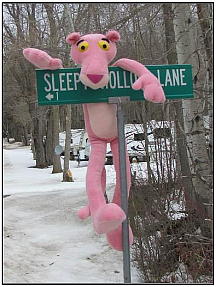 Association or helping with
communal projects such as road maintenance.
Association or helping with
communal projects such as road maintenance.
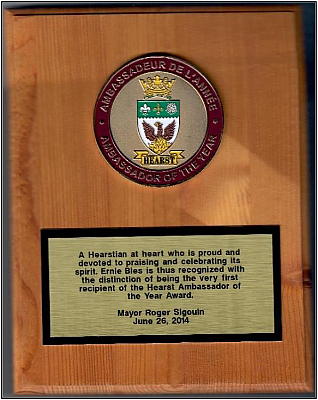
I do have an assistant and the Pink Panther has become well-known on the lake.
A lifetime of volunteering has brought many rewards, such as plaques and medals but the main satisfaction is being able to help others, a lesson instilled by my mother.
Oh Yes, one of my early volunteer efforts in 1965 resulted in meeting my life partner Sandy. We will celebrate fifty-five years of marriage this year.
I could not have done all of this community work without the support of my family.
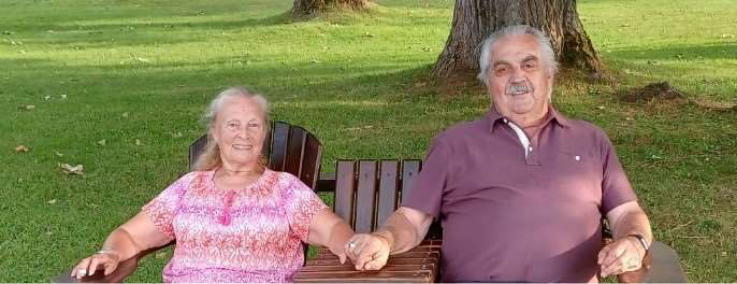
Can you provide corrections or comments?
Please Email Ernie Bies.
For technical websie issues:
Please Email Charlie Dobie.